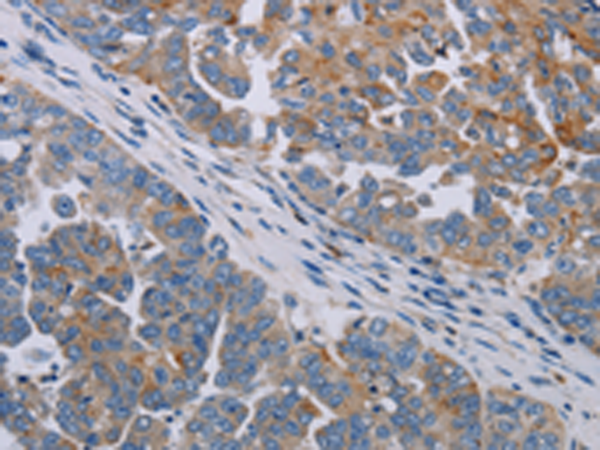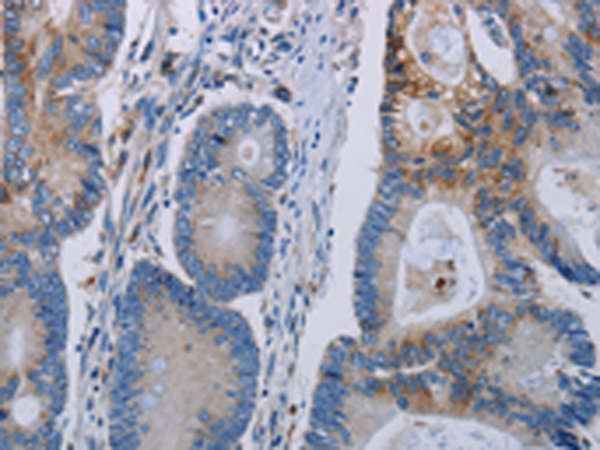

| WB | 咨询技术 | Human,Mouse,Rat |
| IF | 咨询技术 | Human,Mouse,Rat |
| IHC | 1/25-1/100 | Human,Mouse,Rat |
| ICC | 技术咨询 | Human,Mouse,Rat |
| FCM | 咨询技术 | Human,Mouse,Rat |
| Elisa | 1/1000-1/2000 | Human,Mouse,Rat |
| Aliases | ARTD10 |
| Host/Isotype | Rabbit IgG |
| Antibody Type | Primary antibody |
| Storage | Store at 4°C short term. Aliquot and store at -20°C long term. Avoid freeze/thaw cycles. |
| Species Reactivity | Human |
| Immunogen | Synthetic peptide of human PARP10 |
| Formulation | Purified antibody in PBS with 0.05% sodium azide and 50% glycerol. |
+ +
以下是关于PARP10抗体的3篇参考文献,按文献名称、作者和摘要内容简要概括:
1. **文献名称**:*"PARP10/ARTD10 interacts with proliferating cell nuclear antigen (PCNA) and regulates replication-associated DNA damage"*
**作者**:Nicolae CM 等
**摘要**:该研究利用特异性PARP10抗体,通过免疫共沉淀和免疫荧光实验,发现PARP10与PCNA相互作用,参与调控DNA复制过程中的损伤修复,提示其在基因组稳定性中的作用。
2. **文献名称**:*"Structural and functional analysis of PARP10 reveals a nucleosome-dependent role in DNA damage response"*
**作者**:Andersson CD 等
**摘要**:通过开发高特异性PARP10抗体,研究发现PARP10结合核小体并依赖其催化活性参与DNA损伤应答,抗体验证了其在染色质定位中的关键功能。
3. **文献名称**:*"PARP10 suppresses tumor metastasis by regulating focal adhesion kinase inactivation"*
**作者**:Li M 等
**摘要**:该文献使用PARP10抗体进行Western blot和免疫组化分析,证明PARP10通过抑制黏着斑激酶(FAK)磷酸化来阻碍肿瘤细胞迁移和转移,为癌症治疗提供新靶点。
4. **文献名称**:*"Characterization of mono-ADP-ribosyltransferase activity of PARP10 and its interaction with antiviral proteins"*
**作者**:Kleine H, Luscher B
**摘要**:通过免疫沉淀结合质谱分析(使用PARP10特异性抗体),研究揭示了PARP10的酶活性及其与抗病毒蛋白的相互作用,表明其在天然免疫反应中的潜在作用。
以上文献均涉及PARP10抗体的实验应用,涵盖DNA修复、肿瘤转移及免疫调控等领域。
PARP10 (Poly-ADP-ribose polymerase 10) is a member of the PARP enzyme family, which plays diverse roles in DNA repair, transcriptional regulation, and cellular stress responses. Unlike canonical PARPs like PARP1/2. PARP10 primarily functions as a mono-ADP-ribosyltransferase, modifying target proteins to regulate processes such as cell proliferation, apoptosis, and genome stability. It contains a conserved catalytic PARP domain and unique N-terminal and C-terminal regions implicated in substrate recognition and subcellular localization.
PARP10 antibodies are critical tools for studying its expression, localization, and function in both physiological and pathological contexts. These antibodies are widely used in techniques like Western blotting, immunofluorescence, and immunohistochemistry to detect PARP10 in tissues or cultured cells. Research highlights PARP10's dual role in cancer: it may act as an oncogene by promoting cell survival or as a tumor suppressor by maintaining genomic integrity, depending on cellular context. Dysregulation of PARP10 has been linked to cancers, including hepatocellular carcinoma and leukemia, making it a potential biomarker or therapeutic target.
Recent studies also explore PARP10's involvement in antiviral responses and metabolic disorders. Validated antibodies help clarify its interaction networks, such as partnerships with ubiquitin ligases or signaling kinases. Commercial PARP10 antibodies are typically validated using knockout controls to ensure specificity. As PARP inhibitors gain clinical traction, understanding PARP10's distinct mechanisms through antibody-based assays remains vital for uncovering its therapeutic potential.
×